Tired of wasting your time and money on poor-quality leads?
Or perhaps you’re failing to engage hot leads. Before you know it, they’re shaking hands with a competitor. Ouch.
If so, it’s time to start taking purchase intent seriously.
What Is Purchase Intent?
Purchase intent, also known as buyer intent, is a measure of the likelihood that a lead is ready to purchase your product or service.
It’s usually based on information about online behavior, known as intent data. For example, if a lead visits your pricing page or searches for a competing product, these are signals of purchase intent.
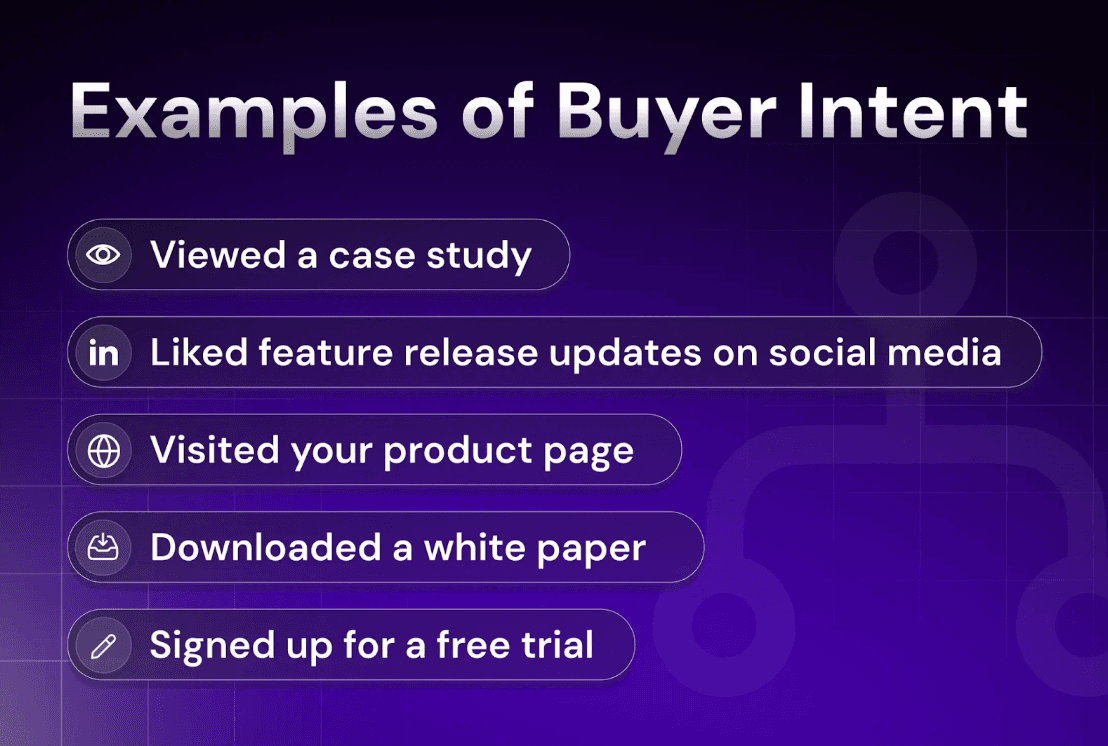
By tracking purchase intent, companies can spot high-quality leads, determine their stage in the customer journey, and send them relevant content and offers.
Because intent-based targeting is so precise, it dramatically enhances the customer experience and boosts sales as a result. It gives your sales team the ability to spot and influence customer decision-making processes that would have otherwise gone unnoticed.
How It Fits in the Funnel
Purchase intent doesn’t operate in a binary way. It’s not a case of a customer having or not having intent, with no middle ground.
It exists on a spectrum, from no intent to high intent. Increasing degrees of intent reflect a lead’s forward progress through the buying process. And businesses often categorize buyer intent by the stages of their marketing funnel.
Here are the three major funnel stages and the level of intent associated with each:
Awareness: Early-stage buyers in the awareness stage have no purchase intent. They might be interested in your brand. But they aren’t behaving in any way that would suggest they’re thinking of making a purchase.
Consideration: These buyers have purchase intent, but it’s fledgling. Perhaps they viewed a demo recording, visited the product page, or chatted with a bot on your site. They are playing with the idea but still not ready for a sales meeting.
Decision: Here are your high-intent potential customers. They’ve signaled that they’re ready and willing to buy. They just need a final nudge. Behaviors that may land them in this category include scheduling a live demo, opening a high percentage of sales emails, and downloading a white paper on how to implement your solution.
Why Purchase Intent Matters
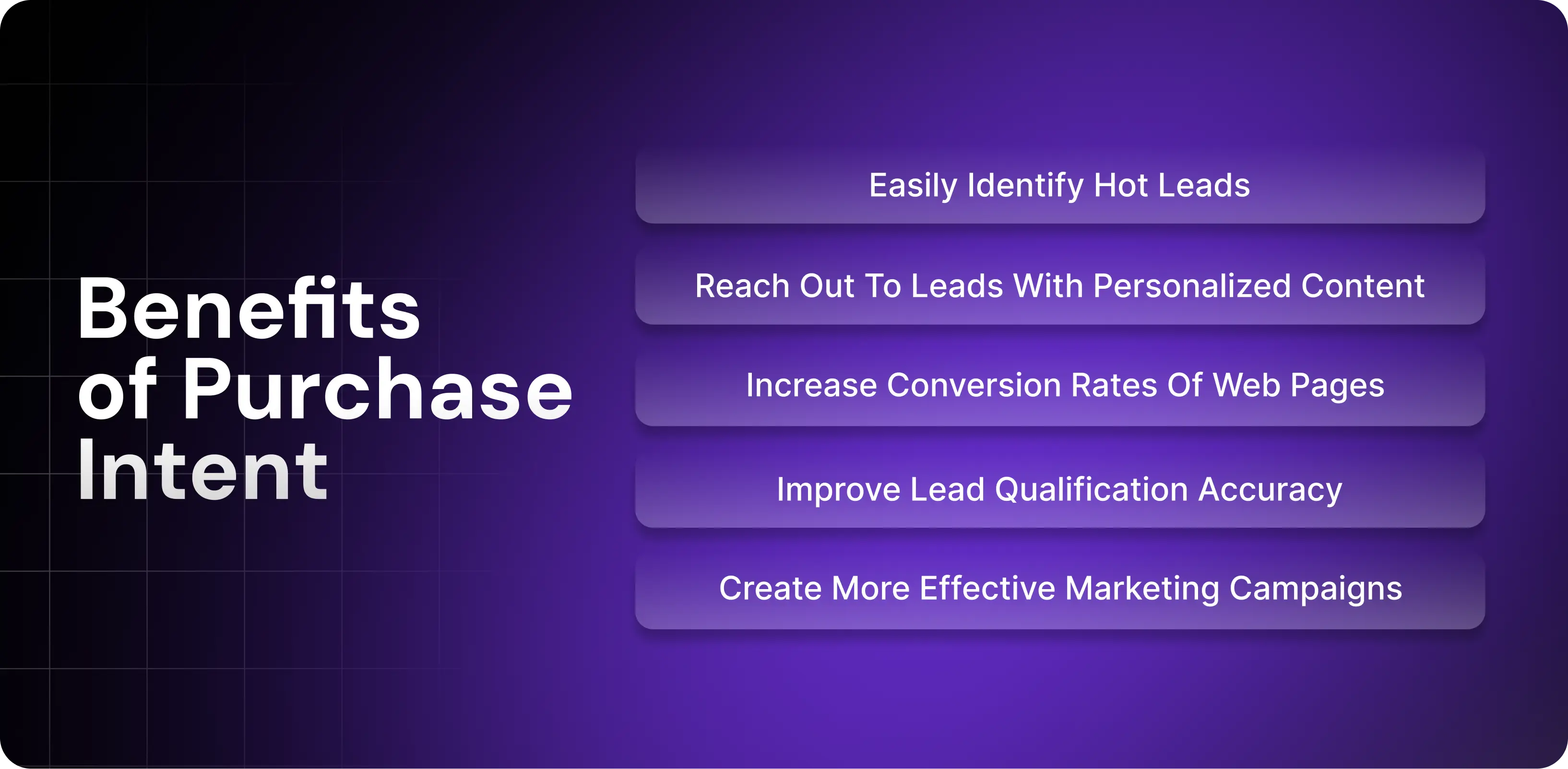
Without tracking purchase intent, it’s almost impossible to categorize leads by their stage in your sales funnel. As a result, you can’t send them relevant marketing content and advertisements.
The upshot is that you don’t know where leads are in the customer journey and what information they need to move forward. You might, for example, send a pricing breakdown to a lead in the awareness stage, scaring them off.
On the other hand, when you track lead behavior and infer buying intent, you can shape your sales and marketing activities based on interest and purchase readiness. This means higher conversion rates, fewer meetings with unqualified leads, and a better return on investment.
Real Outcomes
Here are the tangible results of using real-time purchasing intent data in your sales and marketing strategies:
Faster sales cycle: Because sales reps are only meeting with companies actively interested in buying your solution, it takes less time to close deals.
Reduced CAC: By efficiently allocating your marketing and sales budget to the right prospects and never wasting it on low-quality leads, it costs less to acquire new customers.
Higher campaign conversion rates: Whether an email marketing sequence or a cold calling sprint, your campaigns will convert at a higher rate when directed at leads who are ready and willing to buy.
How to Identify Intent Signals
To identify purchase intent, you must track intent data—the online behavior of leads that suggests readiness to buy.
There are two kinds of intent data: first-party and third-party. Let’s look at how to find both.
First-Party Data
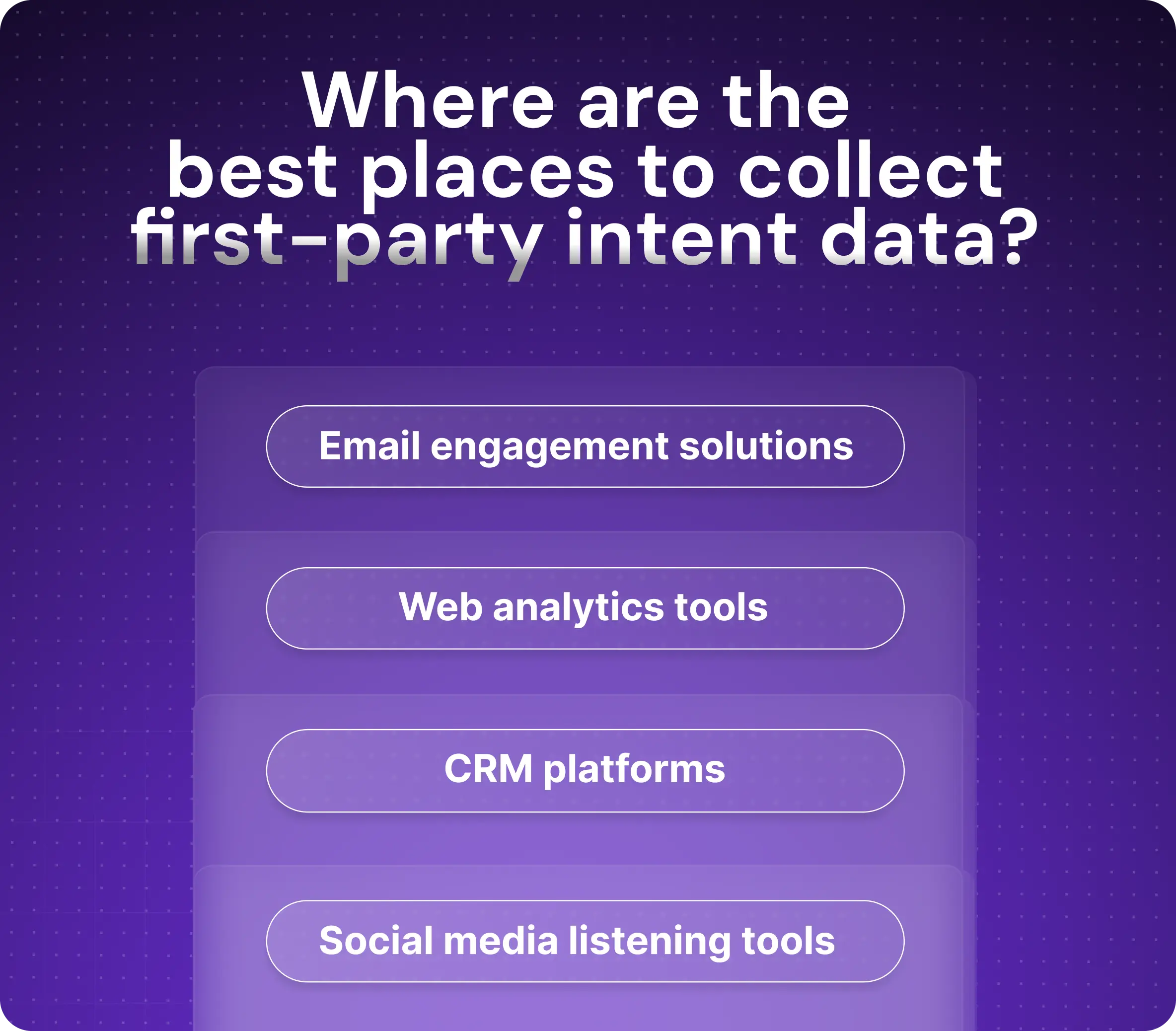
First-party intent data is information you collect from your own sales and marketing channels and software platforms.
For example, if a lead downloaded pricing information from your website, that action is likely tracked in your CRM and a clear sign of strong intent.
Here are four top places to find this first-party intent data:
Website analytics tools: Use website tracking tools to see which target accounts are visiting your site. Look for intent indicators like time spent viewing a pricing page, multiple visits to a feature demo, or downloads of product white papers.
Outreach software: Use the analytics features of your email marketing and sales engagement platforms to track email opens, clicks, and replies. High engagement, especially with product-related emails, is a sign of strong purchase intent.
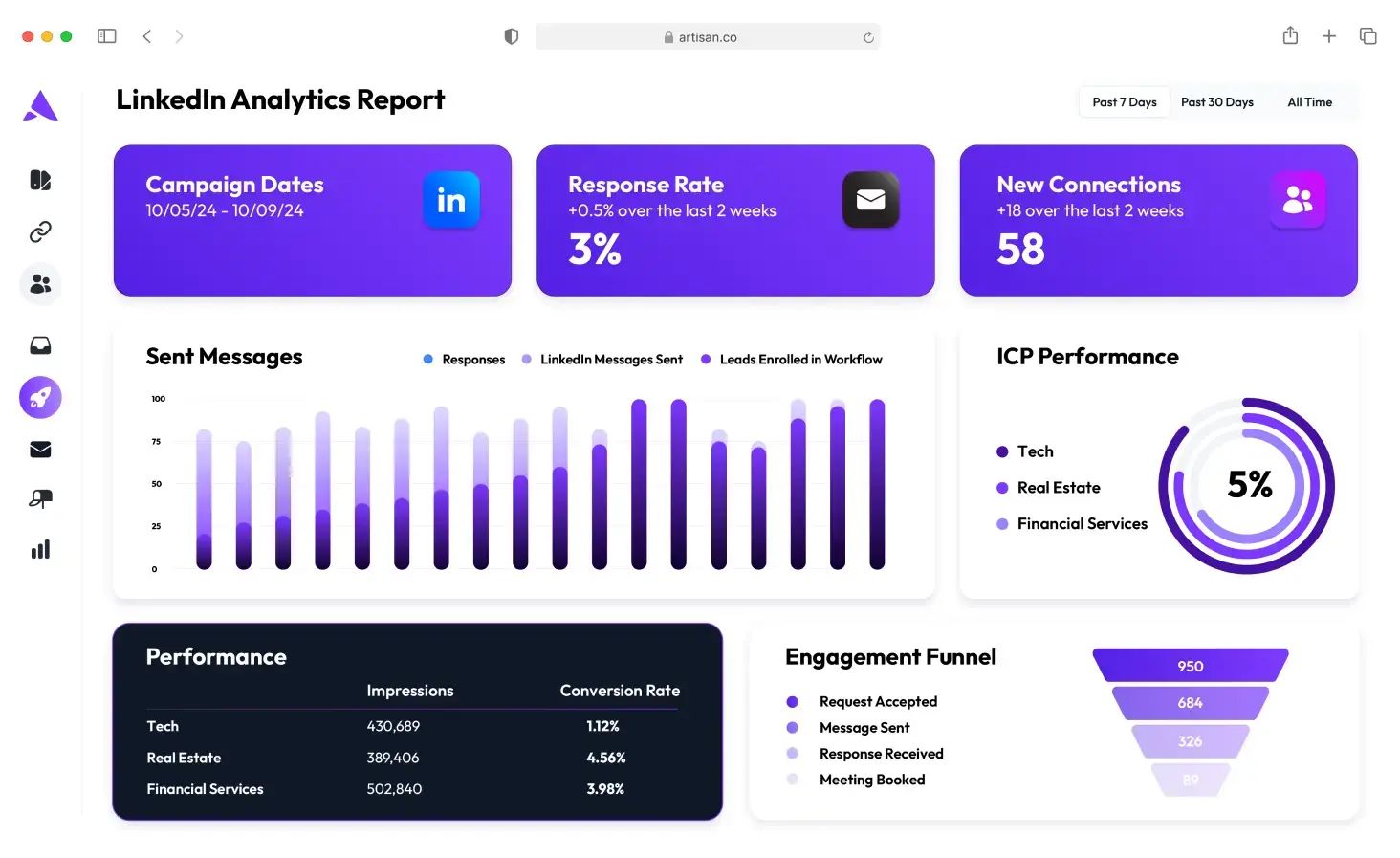
Social media listening tools: These solutions allow you to track mentions of your brand, competitors, and industry-related keywords on social media. Look for leads who are posting about challenges you solve and interacting frequently with your content.
CRM platforms: Use your CRM to track how leads are interacting with your sales team. Are they making demo requests or pricing inquiries? Are they emailing consistently with a sales rep? These are all signs of purchase intent.
Third-Party Data
Third-party intent data is collected and aggregated by third-party data providers.
It’s useful because it gives you visibility into how leads are behaving outside of your own digital properties—for example, when they’re on Google searching for products like yours.
Here are the two best tools for gathering third-party intent data:
Bombora: Monitors when professionals at target accounts are searching for topics relevant to your business, thus providing insights into company-level buying intent.
G2: Tracks buyer behavior on its popular software review site, spotting professionals who are actively comparing solutions, reading reviews, and engaging with category pages.
If you use LinkedIn Sales Navigator, there’s a feature called Buyer Intent that enables you to see if your targets are showing intent on the platform.
How to Optimize Campaigns with Intent
Identifying buying intent is one thing. Running intent-based marketing campaigns is how you turn insights into revenue.
Jazz Su, a digital marketing manager at B2B wholesale platform Shewin, saw a significant boost in account sign-ups by acting on just one piece of intent data:
“When we noticed a pattern of boutique owners downloading our wholesale catalogs but not completing purchases, we created personalized email sequences with targeted content about our minimum order quantities and quick turnaround times. This strategy led to a 47% increase in wholesale account sign-ups within three months.”
So, how can you incorporate intent signals into your advertising and content marketing like Jazz did?
Keywords & Ads
An intent-based advertising strategy focuses ad spend on leads who are actively researching solutions like yours. When ads also incorporate up-to-date demographic and firmographic targeting, the increase in click-through rates can be substantial.
Here are the best ways to integrate intent data into your ad strategies:
Run Google Ad campaigns that target users searching for specific search terms like product names and technical specifications.
Create retargeting audiences by segmenting web visitors based on the pages they’ve visited—for example, those who visited a specific feature page will receive ads about that feature.
Serve ABM ads to high-value accounts: If a target account has shown intent—by visiting your site, for example—ABM ads will likely deliver positive return on ad spend (ROAS).
Content Strategy
To leverage buyer intent in content marketing, start by creating assets for different intent tiers. This way, leads receive content that matches their current needs, questions, and mindsets.
Here are the best types of content to create for each tier:
Early-stage prospects (no intent): New prospects need educational content that helps them understand the problem they’ve only just discovered. Common content types are blog posts, industry reports, and thought leadership articles. Aim for trust, not sales.
Mid-stage prospects (low intent): These buyers are researching solutions. Help them out with content that teaches them about your product. Feature explanations, comparison guides, and breakdowns of your business category are good examples.
Late-stage prospects (high intent): High-intent prospects have identified your business as a top contender. Help them make the decision with pricing guides, implementation white papers, demo recordings, and case studies.
If your marketing automation software allows, consider creating dynamic landing pages, email campaigns, and gated offers that adapt based on the lead’s intent signals and traffic source. This creates a highly personalized experience and research shows that personalization boosts conversion rates.
For example, you could set up an automation that tracks intent data and assigns leads to the most appropriate campaign. A lead who signs up for your newsletter from the pricing page might enter a promotional campaign, while one who signs up from your homepage goes to a lead nurturing sequence.
At Artisan, we have a variety of landing pages to match all types of intent. Here’s what leads see if they Google “best AI SDR,” for example.
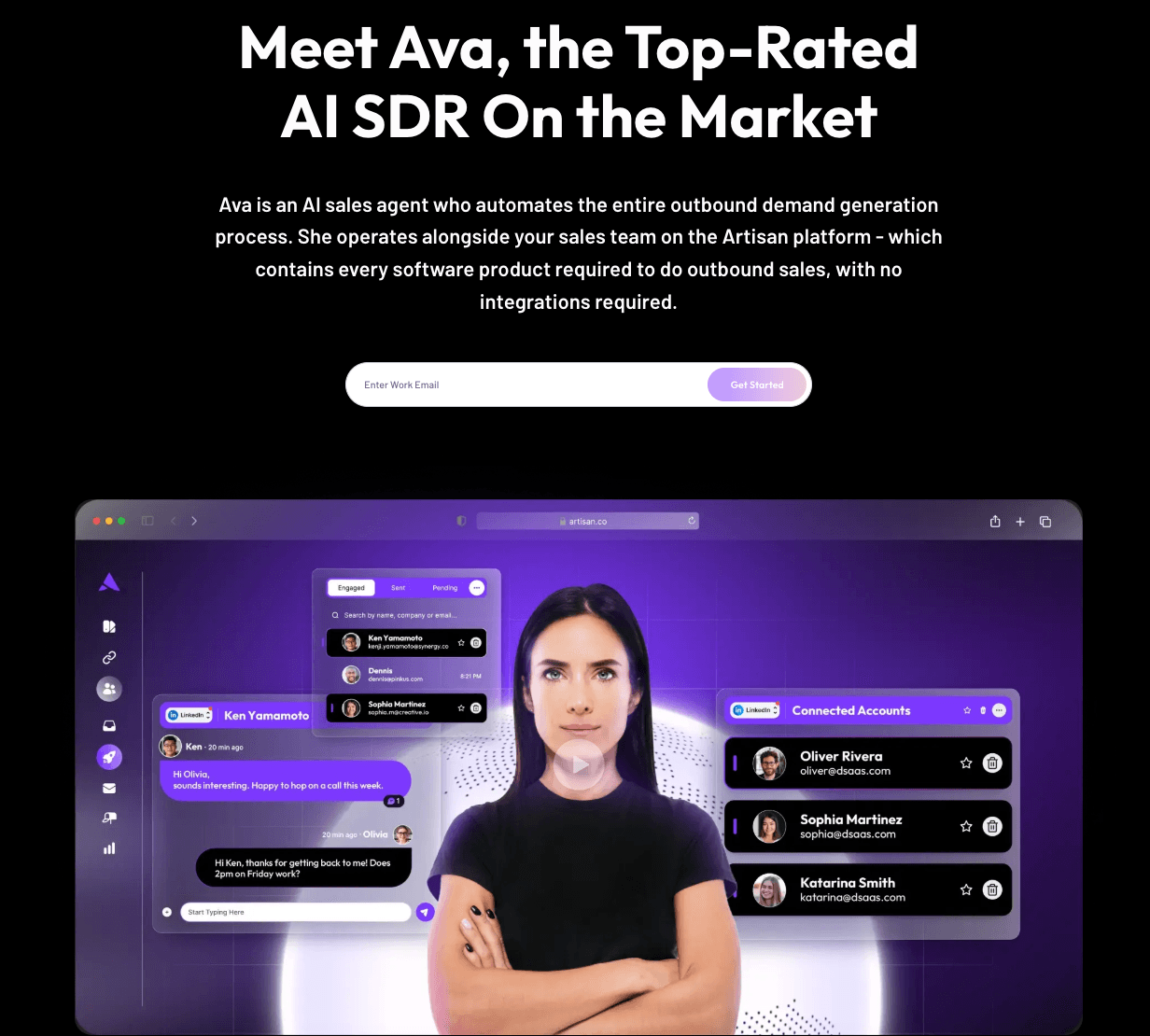
How Sales Can Act on Intent
A sales strategy that uses buyer intent is more personalized, timely, and efficient than one that targets leads based only on demographics.
Vladimir Lebedenko, the Head of Marketing at HostZealot, ran a lead generation campaign that sent users a downloadable server configuration guide. His team then tracked the behavior of leads who downloaded it but didn’t make a purchase. And they noticed something odd.
“Users who read to the end of the guide but didn’t convert ended up visiting our knowledge base three to five times over the next few days. Rather than follow up with a hard-sell CTA, we triggered a contextual email with a subject line that simply said, ‘Want to see how this setup works in the real world?’ and linked to a detailed case study of a similar client in their industry.”
By studying lead’s online behavior, HostZealot was able to identify the current informational needs of high-intent prospects and satisfy them. The outcome? Nearly double the response rate of their typical sales follow-ups.
Let’s look at how you can use buyer intent data to achieve similar results.
Lead Scoring & Qualification
Instead of scoring leads on data points like their job title, location, and industry, start including intent signals in your model.
This will help your sales team find leads who aren’t just a good fit but also ready to buy, resulting in improved lead qualification and fewer meetings with total duds.
Here are the most important intent behaviors to factor into your lead scoring model:
Website visits and session length on product-related pages
Content downloads, especially of pricing guides, case studies, and other late-stage lead magnets
Email engagement patterns like clicks, opens, and replies
Form submissions, especially for demo requests, consultations, and sales calls
Search behavior, such as when leads look up your business category, competitors, or brand name
Most CRMs have lead scoring tools nowadays. They also allow you to integrate various in-house and third-party intent data sources.
For example, let’s say a sales team wants to include email engagement as a scoring factor. They could do this simply by connecting their email marketing software—where engagement is tracked—to the CRM and updating the scoring model’s criteria.
Automated Outreach
Let’s say a lead searches for “SEO consultants.” Moments later, they receive a cold email from an SEO consultant. Spooky? Maybe a bit. Effective? You bet.
This is called intent-based outreach automation. It involves outbound sales teams using sales automation tools to automatically send emails and social messages to leads who have taken some action suggestive of purchase intent.
The easiest way to set up intent-based outreach automation is with an AI sales automation tool. Artisan’s AI BDR Ava, for example, monitors lead behavior on the web and social media and sends highly personalized messages based on this activity.
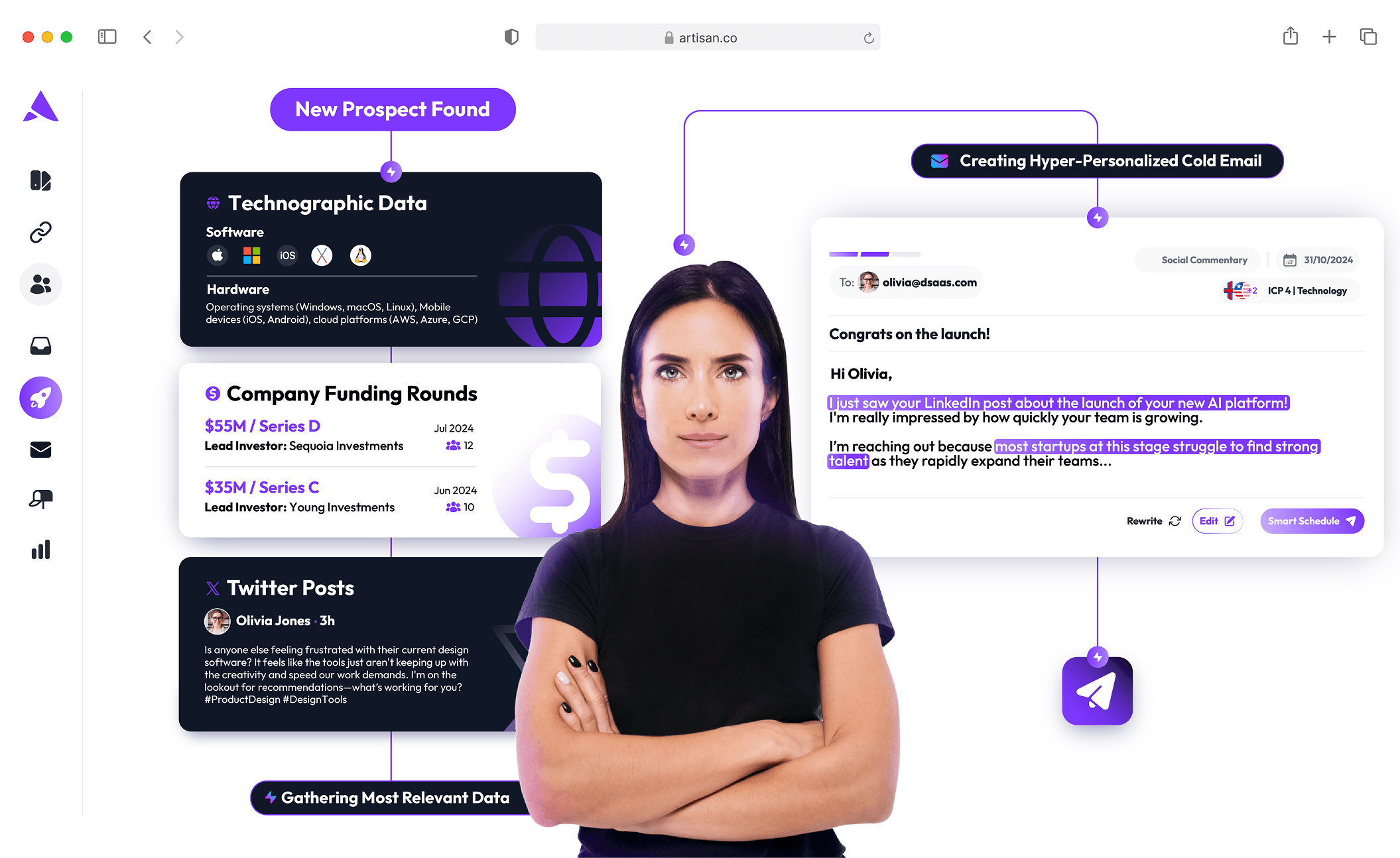
Turning Intent Into Revenue
You’ve identified high-intent leads and set up marketing campaigns to reach and convert them.
Job done, right? Hold up just a second.
Conversion rate optimization (CRO) is the final—but still crucial—last step. It guarantees that you’re generating the greatest possible return from your intent-based targeting.
CRO Best Practices
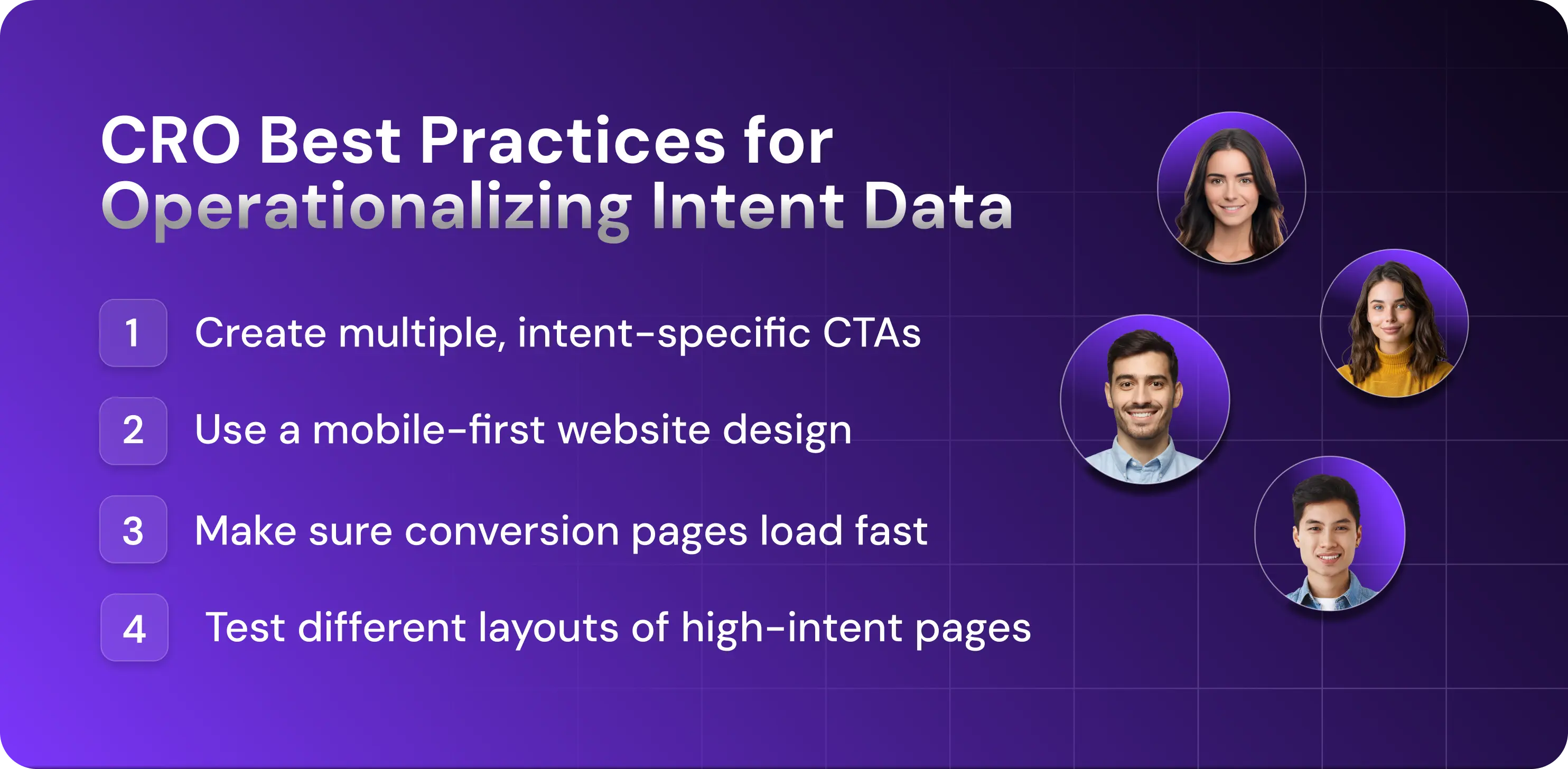
Here’s how to optimize your campaigns to turn intent into revenue:
Create clear, intent-specific CTAs: Create multiple CTAs, one for each level of buyer intent. For example, use a “Download your free trial” CTA for medium-intent buyers, and a “Schedule your sales demo” CTA for high-intent, sales-ready leads.
Use a mobile-first design: Many B2B decision-makers research solutions on their phones, so make sure your website and high-intent pages are mobile-friendly.
Obsess over page speed: B2B websites that load in one second have conversion rates three times higher than sites that load in five seconds, according to research by Portent. Use Google PageSpeed Insights to test the speed of your pages. This tool will tell you if there’s anything wrong and suggest how to fix it.
Identify proven layouts: A/B test customer testimonials, value propositions, CTAs, and other aspects of your landing pages.
Incentives
Fee incentives push leads to act on their intent and meet with a sales rep. Preferably, these offers are low-friction and valuable. They should also help the lead experience the value of your solution, such as somebody test driving a new car.
Here are the best incentives to turn interested leads into sales-ready prospects:
Live, custom demos: Provide a platform walkthrough, with a focus on the features that relate to their specific pain points and use cases. To improve form conversions, make it easy to fill out. Capture only essential lead information. HubSpot offers a good example:
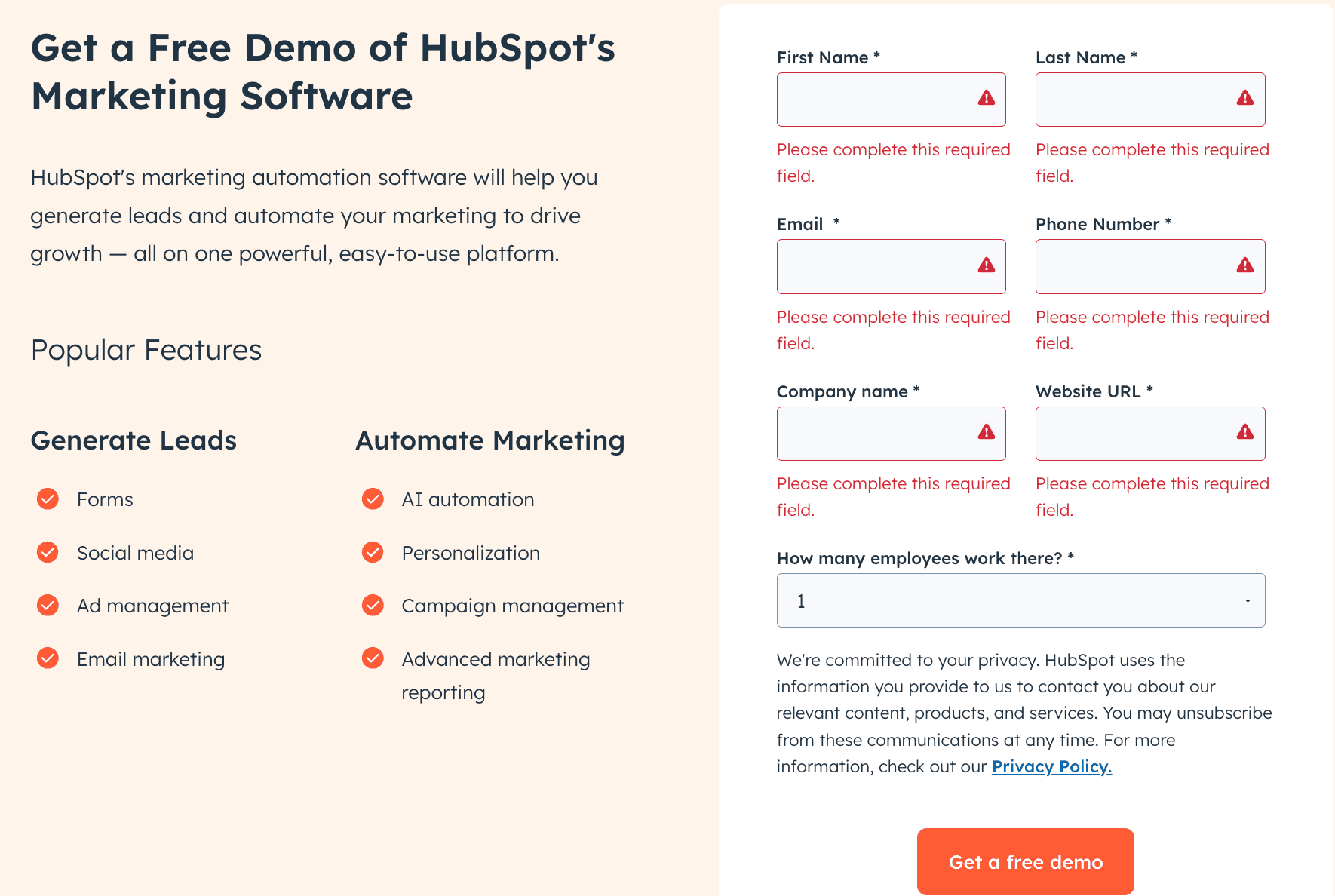
Free trials: Give leads the opportunity to use the core features in your platform for a limited time—anywhere from 7 to 30 days. Be sure to check in on them regularly to see if they need guidance.
Limited-time discounts: Sometimes, leads just need a reason to act fast. A slight discount (15–25%) that expires at a certain date is a great way to create a sense of urgency. You could even combine this with a free trial, as Salesforce does in the example below.
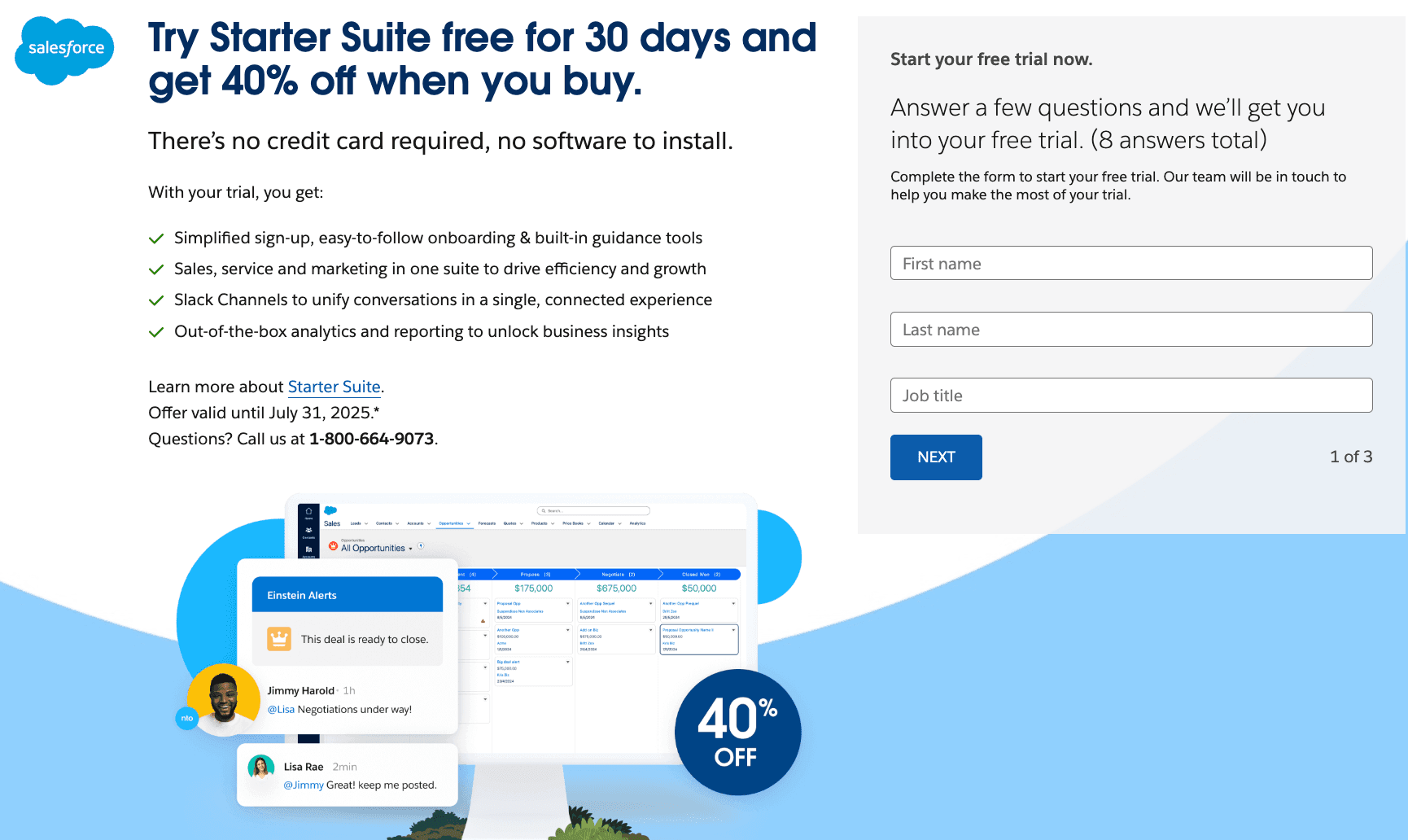
If you want to get extra fancy, create multiple incentives and offer them to leads based on their buying intent.
For example, leads showing price sensitivity might be offered a discount. Meanwhile, leads asking your website chatbot a lot of questions about features receive a live demo offer. This way, prospects see the incentive that best matches their intent.
Make Purchase Intent Your Shortcut to Sales
Companies that use purchase intent data have more effective marketing campaigns, more productive sales teams, and better customer satisfaction.
Why? Because they target leads actively researching their solutions, not semi-random people that have the same job title as their favorite customer.
What’s more, the smartest reps are using AI to refine and scale their campaigns even more.
Artisan tracks lead behavior across a range of touchpoints and sends deeply personalized email and social messages—on autopilot and at a fraction of the cost of a human sales rep.


